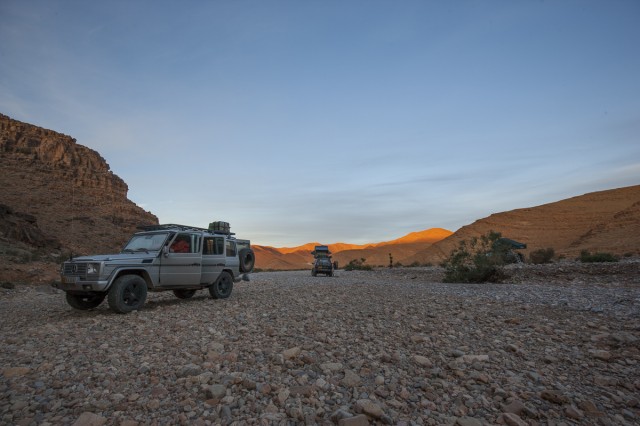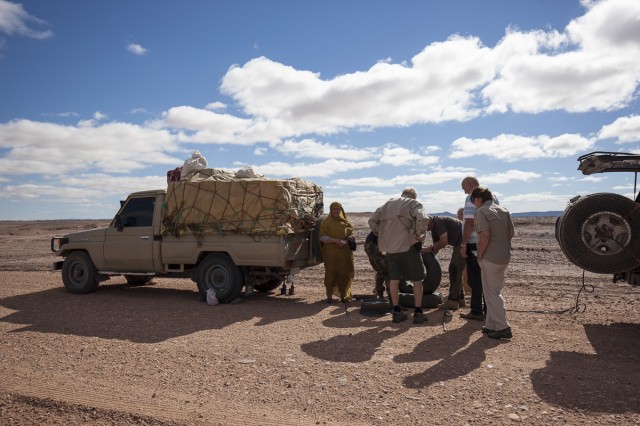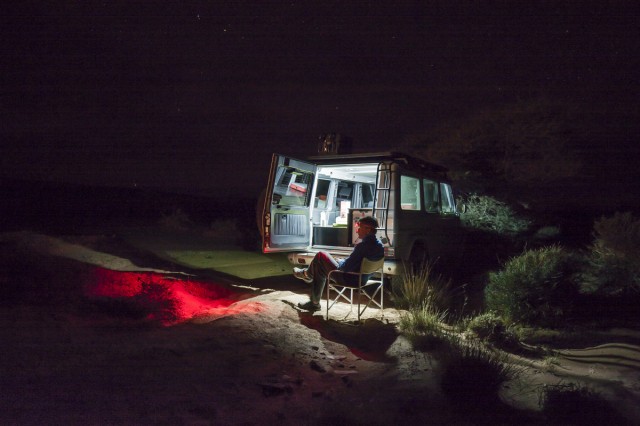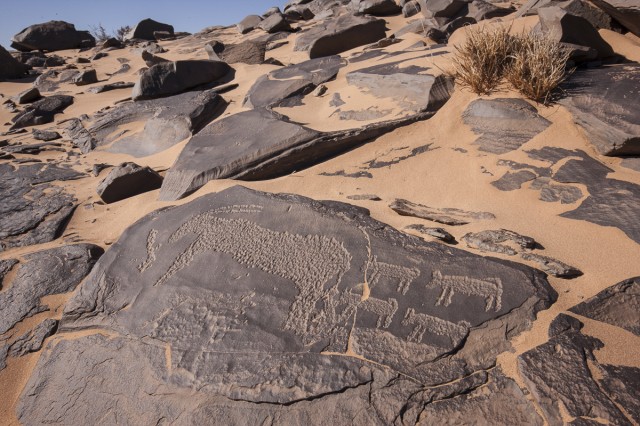Once again, the Expedition Portal forums reveal yet another amazing adventure, this time from forum member, thebigblue. Their three week trek through North Africa has been chronicled in stunning detail with over one hundred vivid images. Below is just a small sampling of those images and the write-up that goes with them. You can read the entire thread [here].
From thebigblue:
The story actually begins on day two in Morocco, – day one was spend driving south on the autoroute network, as well as most of this day too. But finally we reached the southern faces of the Anti-Atlas mountains and got off the highways and the tarmac. Luckily the heavy rainfall finally cleared and we had a undisturbed view of the blue skies, and some dry gravel to camp on; the sun-rays from the setting sun in the dust above the small village nearby was quite spectacular.
I woke up early this morning. All was still extremely silent in camp, no one was awake besides myself. It was fairly bright outside; but sunrise was still an event of the future. So I quickly unziped my sleping bag, got dressed and hastily grabbed the new to me Digital SLR, a secondhand full-frame Canon EOS 1Ds MKIII acquired just half a year ago, and mounted the all new wide-angel lens from Canon, the EF 16-35 mm. f/4.0L IS to it; – I then set off into the mountaintops surrounding our camp to capture some sun-rays in the soft light before sunrise, and to just enjoy it all from an elevated point. So the much needed morning shave and wash would have to wait. I could not be bothered by such triviality at this time.
I was roaming the Anti-Atlas mountains in Morocco, armed with my lovely camera, surrounded by beautiful landscapes, blue skies and the sun was just about to rise above the mountaintops – what more could one ask for.
Here I had everything I need from life; some basic hardware and clothes wrapped inside my Geländewagen, – plus some solitude and great vistas to shoot and capture. In this moment I made the final decision to change my priorities in life.
Then suddenly it all happened, and although I was prepared for this event, the burst of light that rose above the surface of the earth and shined into my pupils, causing me some pain in my eyes when staring directly at it; – it all still startled me, kind-off caught me by surprise, unprepared, off-guard.
The strong red glow from the early sun-rays enhanced the red color-cast in the rocks and hillsides, making it all a very saturated impression. The sky, deep-blue in color and the few and scattered orange clouds offered it’s contribution to the impressionistic look of it all. As the sun rapidly rose further and eventually broke free from the shade of the Anti-Atlas mountaintops, the landscape progressively changed in color and shifted in character. The surreal warm red-orange cast in the early rays changed by the minutes; decreased its saturation, fading in color and shifting into a more bright and yellowish glow. The once very long shadows, all newborn at the first early sunshine, faded slowly and grew shorter and shorter with each inch the sun gained in altitude.
I was filled with joy and happiness on my view upon all this, and also by the powerful silence of the morning; – I hastily shifted position and elevation to get as many exposures and compositions as possible. To make the most of this early morning alone with my camera in the mountains.
Stargazing in North Africa is a special thing, one factor increases the experience, another ruins it. Two forces battling each other, one caused by the absence of man, the other is a natural phenomenon.
Light pollution in Morocco is not a great problem and the view to the night skies benefit from this. But the fairly great amount of dust and small sand-particles flying around beneath the stars obstruct the view, and causes an enormous fading of the light emitting from the distant stars and galaxies. On the Northern hemisphere a 30 sec. exposure-time will be sufficient when photographing stars; but here the light-loss will mean that an exposure around 120 to 180 seconds is needed. Causing stars to become blured lines instead of prominent bright dots on the sky.
Still, – it is always a very special felling to lean your head back a bit and lay your eyes at rest on the milky-way glowing in the dark just above the horizon.
We from Europe, Scandinavia or from similar places in the first world are used to having easy access to fresh clean water, we normally take it for granted and never really think about it. Still, we all know that fresh clean water are becoming more and more difficult to get and access for many people all over the world.
When you travel deeper south into Morocco and the Anit-Atlas you will be reminded about this fact numerous times every single day. Driving all day on the beautiful desolated dusty pistes in your adventure truck; you will have a view to the dry land and be an eyewitness to the war the locals constantly fight to gather water to sustain their living and so desperately need for their crops and livestock.
And then, when you suddenly unprepared find yourself standing up front to a dead camel laying in a dry oued (wadi) in the desert; it becomes painfully obvious to you that water is still so very difficult to find and access in the desert. These camels is worth a fortune for the locals; and still they are deadly victims from the lack of water here.
Although a dead camel is serious business it’s difficult not to enjoy the spectacular vistas here, especially the hour around sunrises and sunsets is a bombardment of colors, – and smells. Due to the fact that most of the surfaces here is covered in rock, gravel and dust; all mostly in red colors adds to the color-cast when the sun is low in the horizon.
I try to make and effort to enjoy these lovely hours in camp, being either early in the morning or late afternoon.
Suddenly, in the middle of the desert and quite far from the main piste, – out of nowhere it seemed, a young Moroccan male approached us. Although several of us in the travel-party speak some basic french; we were unable to communicate by other means than sign-language. The universal default fallback when everything else fails.
It appeared that he had some kind of problem with a vehicle, might be a bad wheel or a puncture; and he asked for our assistance. In these desolated regions we all help each other, no matter which language we speak or what religion we have, if even being a religions person. So we tucked him inside a truck and onto the passenger seat and we all then took off to participate in the roadside assistance. When we after some off-piste driving reached the main gravel-piste, given directions from the local Moroccan, we saw a lovely old TOYOTA 70-series Landcruiser truck; with indeed a flat tire. Another young male and an older woman was at the spot, waiting in the shade from the truck. It appeared the two young men were brothers, and the woman would be their mother; they were headed into town for the marked.
In these regions of Morocco you must be somewhat richer than the average person to own a truck, – and also to be able to afford fuel for it. Still the tires were a badly worn with nearly no tread left on a few of them. All tires had tubing, and apparently they had failed in fixing the leakage with a pad. Paul, our guide, brings a kit with everything thinkable in his 80-series Landcruiser. And with some jointed effort the tube was repaired and inflated. The poor guys had only a bicycle pump at their disposal, so some compressed air from the LC´s electrical driven pump was appreciated.
While we were at it, the locals also asked for assistance for another puncture. But when the wheel was taken apart it was obvious that the tubing was worn beyond repair. We then greeted each other farewell – and “bon route”, – we then took off in separate directions, the locals heading on towards town on the gravel-piste, us back to the scheduled route for the day, meaning some off-piste for starters. Note: a day in the North-West African desert never goes according to plan.
From the first moment when I woke up in my Geländewagen in camp this morning the weather showed promises of a great sunny and hot day. And although yesterday had turned out to be a rather nice one, with lost of warmth and loads of sunshine to tan our pale skins, I wanted more of this, more sunshine and blue skies.
November is the dullest month in Scandinavia were I live and work, – the weather is usually a maze of greys and blacks, fog, overcast, poor on light and rich on rain and winds. At least December is a short one work-wise with several holidays. And Christmas also arrives whether you want it to or not, I´m not big on Christmas, but it´s a lovely excuse to bee with family. January and February will often be far better, maybe it will even bring some snowfall to change the landscape. You will also have the opportunity to go skiing somewhere up North or in the Alps.
So apart from my yearning to see some desolated beautiful places and landscapes; I come here, to Morocco and the Western Sahara, to get some warmth and some sun in my face. Bring it on please. I had great expectations for this day. Would I be disappointed.
Today we passed the imaginary line, the invisible razor-wire in the middle of the desolated desert. The line was once a border-crossing between Morocco and Spanish Sahara. The history of the resistance war influences us when driving here, – but the imaginary line is also a way-point for us, crossing in to the Western Sahara is somewhat of an achievement to be celebrated, all in due respect for the consequences of the original inhabitants here.
Today the border-line separates the two territory’s that makes up the kingdom of Morocco, Spanish Sahara was just a modern term for the Western Sahara. Spain ruled the territory from 1884 to as late as 1975. Spain gave it up following Moroccan demands and international pressure, mainly from United Nations resolutions regarding decolonization. There was internal pressure from the native Sahrawi population and also the claims of Morocco. Mauritania also claimed the territory for a number of years.
In 1975 Morocco occupied much of the country, but the Polisario Front, promoting sovereignty of an independent Sahrawi Arab Democratic Republic (SADR), fought a guerrilla resistance for 16 years against Morocco. In 1991 the UN negotiated a ceasefire, the UN is still present in the area. Western Sahara was and still is inhabited by Berbers, known as Sahrawi, since ancient times. The best known early form of government in the territory was under the Almoravid Berber empire between 1040 and 1147.
The United Nations considers the former Spanish Sahara a non-self-governing territory, with Spain as the formal administrative power and, since the 1970s, Morocco as the current administrative power.
There is still quite some tension in the area towards the border to Mauritania, as we would experience later our-selves.
Ken and I went ahead in front of the rest of the travel-party, we had stocked up with diesel and really did´t needed any other provisions, apart from a few liters of drinking water. I had the fortune that Paul, our guide, was so kind as to buy me four liters of water. And so Ken and I made it to the cliffs in fairly good time before sunset. We were fortunate to have two hours alone in this quite place before the sun set, and I was lucky to get the opportunity to take some photographs in the soft and warm evening light.
Standing here, once more in this desolated area of the Western Sahara, looking at and admiring these very early drawing made by man in a distant past, makes me very humble and filled with gratitude to be so fortunate as to have this experience.
To have such a spectacular view to this collection of rock-art; made such a long long time ago by early man. Imaged that on this place, where nothing of big stature really lives and growth today, – now a place filled with sand, rock and gravel; – once these plains was inhabited by wild tropical mammals like giraffes, antelopes and maybe elephants. Standing here today it´s extremely difficult to comprehend the changes in climate that has evolved here over time.
You can read the entire thread [here] on Expedition Portal’s forums.




















































